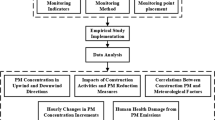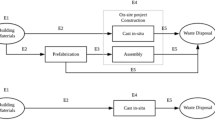Abstract
The level of emissions to the environment imposed by different human activities has been increasing at an alarming rate over the past decades. Measurement and control of air pollutant emissions into the atmosphere can lead towards reducing the emission level considerably. Construction industry is a major contributor to the environmental emissions due to the extensive use of construction equipment, which is responsible for greenhouse gas emissions and harmful substances such as carbon monoxide, nitrogen oxide and particulate matter emissions. Pile foundation is extensively used in high-rise buildings construction and it involves operation of heavy construction equipment. This study developed a process-based model to quantify environmental emissions of equipment usage in a typical pile foundation construction using the US EPA methodology. The emissions of excavation works govern the total emissions at site because of the high usage hours of excavators. In general the emission rates of piling rig and concrete pumping truck were found to be the highest although excavator emission rates are higher for carbon monoxide and particulate matter. It is seen that careful selection of machines and equipment can reduce the emissions up to 10 %. These findings of the study could be effectively used for minimizing the environmental emissions by careful selection of suitable equipment and technology.
Access this chapter
Tax calculation will be finalised at checkout
Purchases are for personal use only
Similar content being viewed by others
References
Abolhasani S, Frey HC, Kim K, Rasdorf W, Lewis P, Pang S-H (2008) Real-world in-use activity, fuel use, and emissions for nonroad construction vehicles: a case study for excavators. J Air Waste Manage Assoc 58:1033–1046
Ariaratnam ST, Sihabuddin SS (2009) Comparison of emitted emissions between trenchless pipe replacement and open cut utility construction. J Green Build 4:126–140
Chau CK, Hui WK, Ng WY, Powell G (2012) Assessment of CO2 emissions reduction in high-rise concrete office buildings using different material use options. Resour Conserv Recycl 61:22–34
Chen GQ, Zhang B (2010) Greenhouse gas emissions in China 2007: inventory and input-output analysis. Energy Policy 38:6180–6193
Chen Y, Zhu Y (2008) Analysis of environmental impacts in the construction phase of concrete frame buildings. Department of Construction Management, Tsinghua University, China
Dong H, Geng Y, Xi F, Fujita T (2013) Carbon footprint evaluation at industrial park level: a hybrid life cycle assessment approach. Energy Policy 57:298–307
Fay R, Treloar G, Iyer-Raniga U (2000) Life-cycle energy analysis of buildings: a case study. Build Res Inf 28:31–41
Frey H, Rasdorf W, Lewis P (2010) Comprehensive field study of fuel use and emissions of nonroad diesel construction equipment. Transp Res Rec: J Transp Res Board 2158:69–76
Graham LA, Rideout G, Rosenblatt D, Hendren J (2008) Greenhouse gas emissions from heavy-duty vehicles. Atmos Environ 42:4665–4681
Guggemos AA (2003) Environmental impacts of on-site construction processes: focus on structural frames. University of California, Berkeley
Guggemos AA, Horvath A (2006) Decision-support tool for assessing the environmental effects of constructing commercial buildings. J Archit Eng 12:187–195
Hannigan PJ, Goble GG, Thendean G, Likins GE, Rausche F (1997) Design and construction of driven pile foundations-volume II
Huberman N, Pearlmutter D (2008) A life-cycle energy analysis of building materials in the Negev desert. Energy Build 40:837–848
Jung S-W, Lee T-W, Kim J-C, Seo C-Y, Ryu J-H, Hwang J-W, Kim S-M, Eom D-S (2009) A study on calculation of air pollutants emission factors for construction equipment. J Korean Soc Atmos Environ 25:188–195
Junnila S, Horvath A (2003) Life-cycle environmental effects of an office building. J Infrastruct Syst 9:157–166
Kean AJ, Sawyer RF, Harley RA (2000) A fuel-based assessment of off-road diesel engine emissions. J Air Waste Manage Assoc 50:1929–1939
Kok R, Benders RMJ, Moll HC (2006) Measuring the environmental load of household consumption using some methods based on input–output energy analysis: a comparison of methods and a discussion of results. Energy Policy 34:2744–2761
Lewis P, Leming M, Rasdorf W (2011) Impact of engine idling on fuel use and CO2 emissions of nonroad diesel construction equipment. J Manage Eng 28:31–38
Li X, Zhu Y, Zhang Z (2010) An LCA-based environmental impact assessment model for construction processes. Build Environ 45:766–775
Mao C, Shen Q, Shen L, Tang L (2013) Comparative study of greenhouse gas emissions between off-site prefabrication and conventional construction methods: two case studies of residential projects. Energy Build 66:165–176
Monahan J, Powell J (2011) An embodied carbon and energy analysis of modern methods of construction in housing: a case study using a lifecycle assessment framework. Energy Build 43:179–188
Paul C (1937) Pile foundation construction. US Patent 2,086,977
Poulos HG, Davis EH (1980) Pile foundation analysis and design
Seo S, Hwang Y (2001) Estimation of CO2 emissions in life cycle of residential buildings. J Constr Eng Manage 127:414–418
Sihabuddin SS, Ariaratnam ST (2009) Methodology for estimating emissions in underground utility construction operations. J Eng, Des Technol 7:37–64
Tomlinson MJ (2001) Foundation design and construction. Pearson Education, New York
Verbeeck G, Hens H (2010) Life cycle inventory of buildings: a calculation method. Build Environ 45:1037–1041
Vesić AS (1975) Principles of pile foundation designs. Duke University, Durham
Xing S, Xu Z, Jun G (2008) Inventory analysis of LCA on steel- and concrete-construction office buildings. Energy Build 40:1188–1193
Yan H, Shen Q, Fan LC, Wang Y, Zhang L (2010) Greenhouse gas emissions in building construction: a case study of one Peking in Hong Kong. Build Environ 45:949–955
Author information
Authors and Affiliations
Corresponding author
Editor information
Editors and Affiliations
Rights and permissions
Copyright information
© 2015 Springer-Verlag Berlin Heidelberg
About this paper
Cite this paper
Sandanayake, M., Zhang, G., Setunge, S., Thomas, C.M. (2015). Environmental Emissions of Construction Equipment Usage in Pile Foundation Construction Process—A Case Study. In: Shen, L., Ye, K., Mao, C. (eds) Proceedings of the 19th International Symposium on Advancement of Construction Management and Real Estate. Springer, Berlin, Heidelberg. https://doi.org/10.1007/978-3-662-46994-1_28
Download citation
DOI: https://doi.org/10.1007/978-3-662-46994-1_28
Published:
Publisher Name: Springer, Berlin, Heidelberg
Print ISBN: 978-3-662-46993-4
Online ISBN: 978-3-662-46994-1
eBook Packages: Business and EconomicsBusiness and Management (R0)




